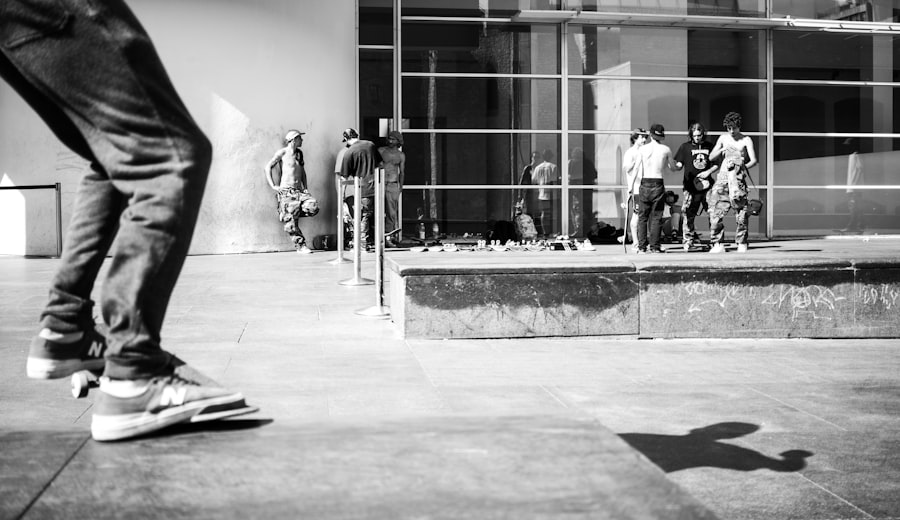Mastering the Art of Table Tennis
Description
Table tennis, often referred to as ping pong, is a fast-paced sport that combines agility, precision, and strategic thinking. Originating in England during the late 19th century as a parlor game, it has evolved into a competitive sport played worldwide. The game is played on a rectangular table divided by a net, with players using small paddles to hit a lightweight ball back and forth.
The objective is to score points by making the ball land on the opponent’s side of the table in such a way that they cannot return it. Understanding the basic rules and structure of the game is essential for anyone looking to engage in table tennis, whether casually or competitively. The game can be played in singles or doubles formats, with each player or team taking turns to serve.
A match is typically played to 11 points, and players must win by at least a two-point margin. The scoring system can vary, with some tournaments adopting a best-of-five or best-of-seven format. Players must also be aware of the service rules, which dictate how the ball must be thrown and struck during a serve.
Familiarity with these fundamental aspects lays the groundwork for more advanced skills and strategies, allowing players to appreciate the nuances of the game as they progress.
Key Takeaways
- Table tennis is a fast-paced game played on a small table with a lightweight ball and paddles.
- Proper technique and form are essential for success in table tennis, including grip, stance, and stroke mechanics.
- Mastering different types of shots, such as the forehand, backhand, and serve, is crucial for competitive play.
- Improving footwork and movement is key to getting into position to make effective shots and cover the table.
- Understanding spin and ball control is important for manipulating the ball and keeping opponents off balance.
Developing Proper Technique and Form
Proper technique and form are crucial for success in table tennis, as they directly influence a player’s ability to execute shots effectively and consistently. The foundation of good technique begins with grip. The two most common grips are the shakehand grip and the penhold grip.
The shakehand grip resembles a handshake and allows for versatility in shot-making, while the penhold grip offers greater control for certain types of strokes. Players should experiment with both grips to determine which feels more comfortable and natural for their playing style. Once a player has established their grip, attention must turn to stance and body positioning.
A balanced stance with feet shoulder-width apart provides stability and readiness for movement. The knees should be slightly bent, allowing for quick lateral movements and explosive power when striking the ball. Additionally, players should maintain an upright posture with their elbows slightly bent, keeping the paddle at waist height for optimal reach.
Practicing these elements in front of a mirror or with a coach can help players develop muscle memory, ensuring that proper form becomes second nature during gameplay.
Mastering Different Types of Shots

In table tennis, mastering various types of shots is essential for becoming a well-rounded player capable of adapting to different opponents and situations. The fundamental shots include the forehand drive, backhand drive, push, and loop. The forehand drive is executed by swinging the paddle forward with a flat trajectory, generating speed and power.
This shot is often used to attack short balls or capitalize on an opponent’s weak return. Conversely, the backhand drive involves a similar motion but is executed on the opposite side of the body, allowing players to maintain offensive pressure from both wings. The push shot is a defensive stroke used to return low balls with backspin, making it difficult for opponents to attack effectively.
This shot requires precise timing and control, as players must angle their paddles correctly to impart spin on the ball. The loop shot, characterized by its high arc and topspin, is an aggressive stroke that can catch opponents off guard. By mastering these shots, players can create a diverse arsenal that keeps their opponents guessing and allows them to dictate the pace of the game.
Improving Footwork and Movement
| Metrics | Measurement |
|---|---|
| Speed | Time taken to move from point A to point B |
| Agility | Ability to change direction quickly and effectively |
| Balance | Stability and control while moving |
| Coordination | Ability to synchronize movements of different body parts |
Footwork is often an overlooked aspect of table tennis training, yet it plays a pivotal role in a player’s overall performance. Effective footwork enables players to position themselves optimally for each shot, ensuring they can generate power and accuracy while maintaining balance. A common drill to improve footwork involves practicing lateral movements across the table while hitting forehand and backhand shots.
This drill not only enhances agility but also reinforces muscle memory for quick adjustments during matches. In addition to lateral movement, players should focus on developing their ability to move forward and backward efficiently. Approaching the table allows players to take advantage of short balls, while retreating can help them prepare for powerful attacks from opponents.
Incorporating agility drills such as ladder exercises or cone sprints into training routines can significantly enhance foot speed and coordination. By prioritizing footwork development, players can elevate their game and respond more effectively to various playing styles.
Understanding Spin and Ball Control
Spin is one of the most critical elements in table tennis, influencing how the ball behaves upon contact with the table and during rallies. Players can impart different types of spin—topspin, backspin, and sidespin—by adjusting their paddle angle and stroke technique. Topspin is generated by brushing up on the ball during contact, causing it to dip quickly after crossing the net.
This type of spin is particularly effective for offensive shots, as it allows players to hit with greater speed while maintaining control. Backspin, on the other hand, is created by brushing down on the ball, resulting in a slower trajectory that can disrupt an opponent’s timing.
Understanding how to generate and respond to different spins is essential for effective ball control. Players should practice against various spins during training sessions to develop their ability to read and react to spin effectively.
Developing Mental Toughness and Focus

Mental toughness is an often underestimated aspect of competitive sports, including table tennis. The ability to maintain focus under pressure can significantly impact performance during matches. Players frequently encounter challenging situations—such as trailing in points or facing a particularly skilled opponent—that test their mental resilience.
Developing strategies for maintaining composure is crucial; techniques such as visualization can help players mentally rehearse successful shots or match scenarios before stepping onto the court. Additionally, cultivating a positive mindset can enhance overall performance. Players should work on reframing negative thoughts into constructive ones, focusing on what they can control rather than dwelling on mistakes or setbacks.
Mindfulness practices such as deep breathing or meditation can also aid in improving concentration during matches. By prioritizing mental training alongside physical skills, players can create a holistic approach that prepares them for both the technical and psychological demands of competitive play.
Utilizing Strategy and Tactics
Strategic thinking is vital in table tennis; understanding when to attack aggressively or play defensively can determine the outcome of a match. Players should analyze their opponents’ strengths and weaknesses throughout gameplay to devise effective strategies tailored to each situation. For instance, if an opponent struggles with high balls, employing loop shots may exploit this weakness effectively.
Conversely, if an opponent excels at counter-hitting fast shots, varying pace and spin can disrupt their rhythm. Tactics also extend beyond individual shot selection; they encompass broader match strategies such as serving patterns and positioning on the table. Players should develop a repertoire of serves that incorporate different spins and placements to keep opponents guessing during service games.
Additionally, understanding when to transition from offense to defense based on an opponent’s responses can create opportunities for scoring points while minimizing risks.
Practicing and Training Effectively
Effective practice is essential for improvement in table tennis; simply hitting balls back and forth will not yield significant progress. Structured training sessions that focus on specific skills—such as serving, footwork drills, or shot execution—are crucial for developing proficiency over time. Players should set clear goals for each practice session, whether it’s improving accuracy on serves or enhancing foot speed through agility drills.
Incorporating match play into training routines is also beneficial; simulated match conditions help players apply their skills under pressure while developing strategic thinking in real-time scenarios. Additionally, seeking feedback from coaches or more experienced players can provide valuable insights into areas needing improvement. By approaching practice with intention and purpose, players can maximize their training efforts and accelerate their development in this dynamic sport.
In conclusion, mastering table tennis requires dedication across multiple dimensions—from understanding fundamental rules to honing technical skills and developing mental resilience. Each aspect contributes uniquely to a player’s overall performance, creating a rich tapestry of challenges and rewards within this exhilarating sport.
If you are a fan of Table Tennis, you may also be interested in learning about the latest trends in social media platforms. Check out this article on TikTok here to see how this app is revolutionizing the way people create and share short videos. Just like Table Tennis requires skill and precision, TikTok challenges users to showcase their creativity in a fun and engaging way.
FAQs
What is table tennis?
Table tennis, also known as ping-pong, is a sport in which two or four players hit a lightweight ball back and forth across a table using small bats.
What are the basic rules of table tennis?
The basic rules of table tennis include serving the ball diagonally over the net, allowing the ball to bounce once on each side of the table, and scoring points when the opponent fails to return the ball.
What equipment is needed to play table tennis?
To play table tennis, players need a table tennis table, table tennis bats (also known as paddles or rackets), table tennis balls, and a net.
What are the health benefits of playing table tennis?
Playing table tennis can improve hand-eye coordination, reflexes, and balance. It also provides a good cardiovascular workout and can help improve mental acuity.
What are the different types of table tennis shots?
Common table tennis shots include the forehand drive, backhand drive, topspin, backspin, and smash. Players use a combination of these shots to outmaneuver their opponents.
What is the history of table tennis?
Table tennis originated in England in the late 19th century as an indoor version of lawn tennis. It has since become a popular sport worldwide and is an Olympic event.





